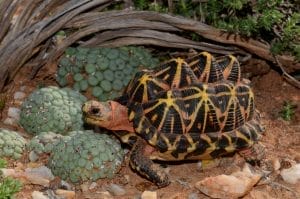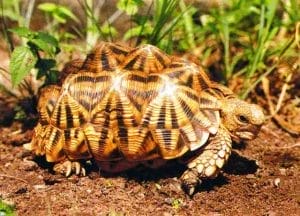Psammobates geometricus (Geometric Tortoise)
Home > Turtle Database > Psammobates geometricus (Geometric Tortoise)

Psammobates geometricus, also known as the geometric tortoise, is one of the most visually striking tortoise species on earth. It’s critically endangered and found only in a small part of South Africa.
Native To These Regions
Western Cape (South Africa)Native Turtle Species Map – Find Turtles by Region
Scientific Classification
Kingdom: Animalia
Phylum: Chordata
Class: Reptilia
Order: Testudines
Family: Testudinidae
Genus: Psammobates
Species: Psammobates geometricus
Common Names
Geometric Tortoise
Geometric Padloper
This Hilarious Turtle Book Might Know Your Pet Better Than You Do
Let’s be real—most turtle care guides feel like reading a textbook written by a sleep-deprived zookeeper.
This one’s not that.
Told from the snarky point of view of a grumpy, judgmental turtle, 21 Turtle Truths You’ll Never Read in a Care Guide is packed with sarcasm, sass, and surprisingly useful insights.
And hey—you don’t have to commit to the whole thing just yet.
Grab 2 free truths from the ebook and get a taste of what your turtle really thinks about your setup, your food choices, and that weird plastic palm tree.
It’s funny, it’s honest, and if you’ve ever owned a turtle who glares at you like you’re the problem—you’ll feel seen.
Identification
Description
This tortoise has a small, domed shell covered in bold black and yellow patterns that resemble geometric starbursts. Adults reach about 12–15 cm in length.
Sexual Dimorphism
Females are usually larger and rounder than males. Males have longer tails and a more concave plastron.
Check more turtles from the Psammobates genus
Native Origin and Distribution
Geographical Range
Endemic to the Western Cape of South Africa, specifically the lowland fynbos region near the Tulbagh and Ceres valleys.
Preferred Habitat
The geometric tortoise lives in renosterveld and lowland fynbos vegetation. It needs dense shrub cover and open spaces for basking and feeding. It avoids cultivated or degraded land.
Behavior
Feeding Habits
It is a herbivore that eats a wide variety of low-growing plants, especially flowers and soft shoots. It forages during the cooler parts of the day.
Predators
Natural predators include birds of prey, mongooses, and jackals. Humans and domestic dogs are also major threats.
Reproduction
Breeding Season
Mating usually occurs in spring after the first rains.
Reproductive Method
Females lay 1–3 eggs in shallow nests. The eggs hatch after several months, depending on temperature and rainfall.
Conservation
Extinction Status
Critically Endangered (IUCN Red List)
Threats
Habitat loss from farming, urban expansion, and invasive alien plants. Fires and road kills also contribute to population decline.
Conservation Measures
Protected in some nature reserves. Efforts include habitat management, land purchase for conservation, and population monitoring.
Economic Importance
It has no direct commercial use but holds high conservation value and draws interest for environmental education and eco-tourism.
Interesting Facts
The geometric tortoise is one of the rarest tortoises in the world. Its shell pattern is so unique that no two individuals look exactly the same. It survives in one of the world’s most threatened plant ecosystems: the Cape Floristic Region.

About Author
Muntaseer Rahman started keeping pet turtles back in 2013. He also owns the largest Turtle & Tortoise Facebook community in Bangladesh. These days he is mostly active on Facebook.













